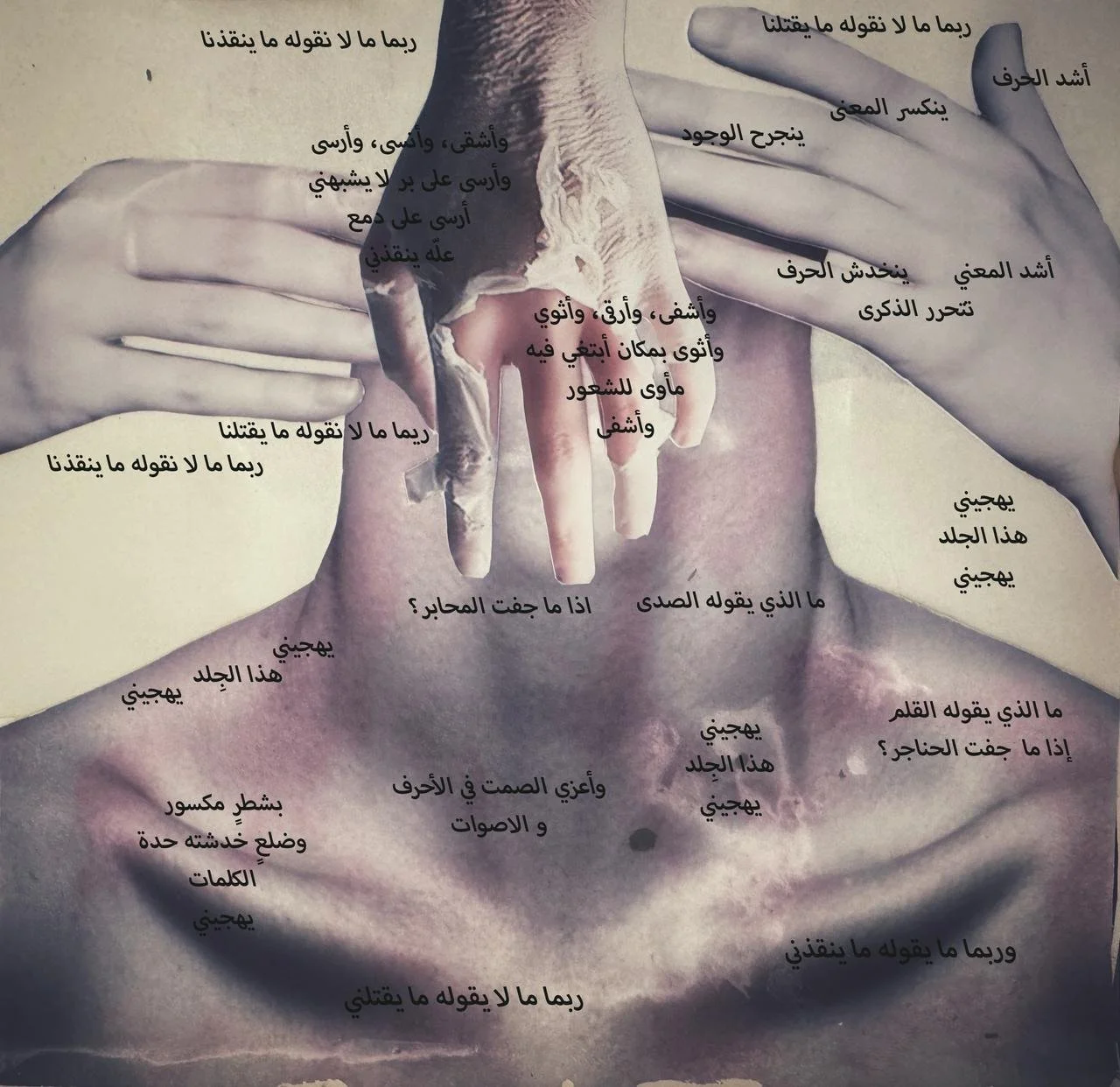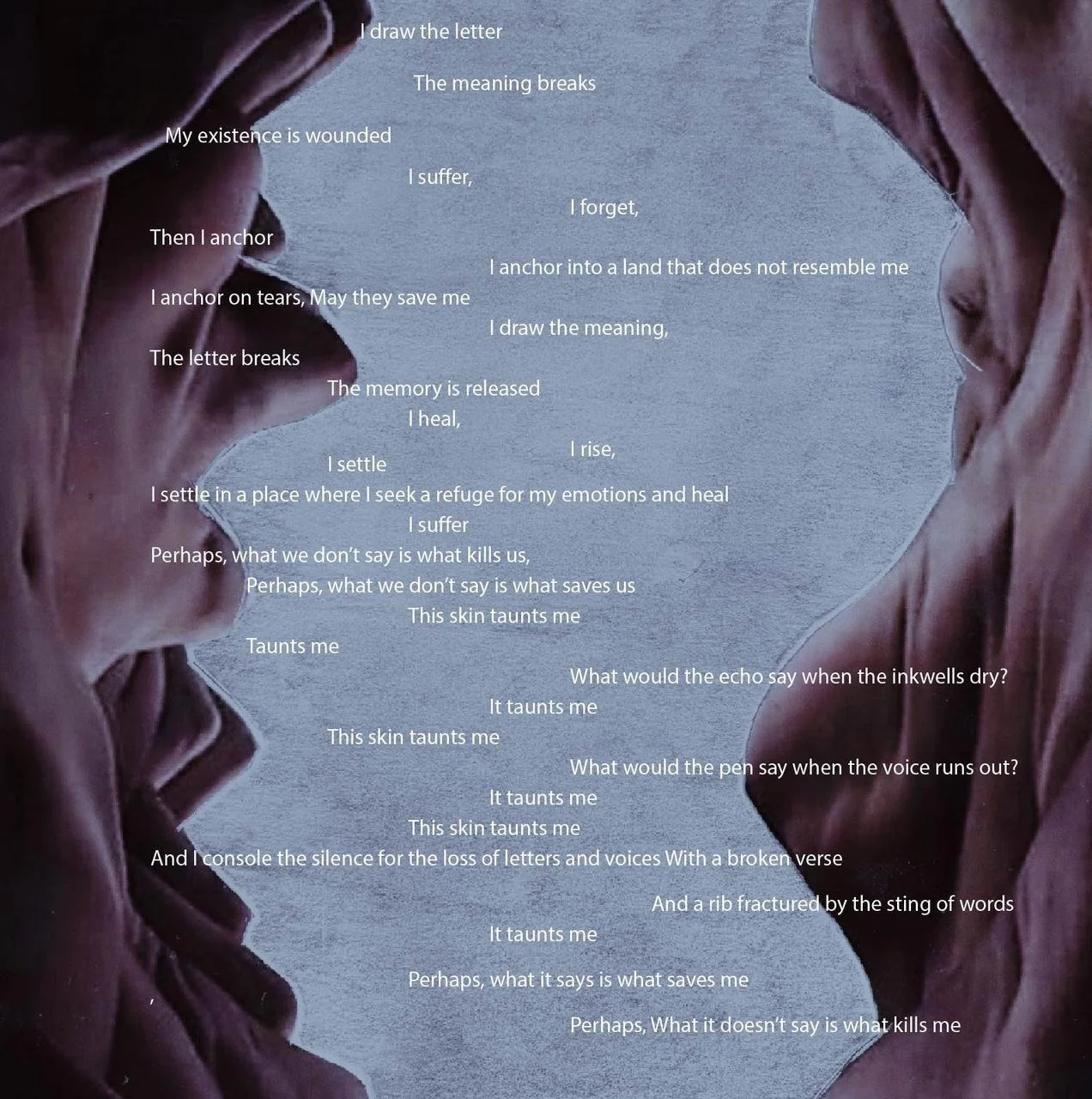هذا الجلد يهجيني (2024)|hijāʼ of the body (2024)
هذا الجلد يهجِيني: أساليب حيّة لتفكيك الصمت
:عُرض ضمن معرض
Whispers of the Unseen: Sonic Alchemy, IKLECTIK Art Lab, London
كتبت «هذا الجلد يهجيني» بالتوازي مع العمل التركيبي البصري لريما تركي ناصر، كجزء من مشروعها النهائي ضمن دراستها للماجستير في البحث النقدي في الكلية الملكية للفنون، بلندن. تبلورت هذه الشراكة خلال حواراتٍ طويلة بدأنا من خلالها في طرح أسئلة تتعلق بالجسد، واللغة، والذاكرة، حيث أخذت هذه الأسئلة بالتشكل بشكل أساسي حول معنى أن يحكي الجسد، لا بشكل رمزي، بل بحميمية، وبُعد سياسي، وشاعرية
مشروع ريما الأخير، جلدٌ من جلدي (2024)، كان بمثابة دعوة قُدّمت لي، للكتابة من خلال الجسد، ومن داخل الجلد. كانت هذه العملية التأملية تنطلق أساسًا لمساءلة المعاني التي ورثتها — معانٍ تشكّلت عبر المكان، والأدوار الجندرية، والتوقعات والصمت
لذلك اتجهت إلى مفهوم الهجاء — لا في معناه التقليدي، بل اتخذت منه ممارسة للتفكيك
أسلوب في الانكشاف
.طريقة للحكي حين تتكسر اللغة
يروي النص هجاءً داخليًا: مواجهة مع الذاكرة، والعار، والقصص التي يحملها الجسد. لا يسعى إلى التجميل أو الخلاص
ينكسر
يُقاوم الاحتواء
:ويطرح السؤال
كيف نتعامل مع الصمت المتوتر؟
ماذا لو أن جلدنا يهاجمنا؟ يحكم، ويتذكر، ويرفض النسيان؟
.هذا الجلد يهجِيني» ليست استعارة، بل واقع»
.شاعرية النشاز — حيث تصبح الكلمات المكسورة والأصوات المنحنية مأوى للمشاعر
يأتي الهجاء كإيماءة نحو شفاء بمنطلقات نقدية. مساحة لا يُكسر فيها الصمت، بل يُصغى إليه بعد أن يُفكك
كل الامتنان ليارا الدباغ على الترجمة الانجليزية
Stills from the video installation
Hijāʼ of the Body: A Poetic Method for Undoing Silence
Exhibited as part of Whispers of the Unseen: Sonic Alchemy at IKLECTIK Art Lab, London
This text was created in dialogue with Reema Turki Nasser’s video installation, part of her Master’s in Research at the Royal College of Art. Our collaboration unfolded through conversations in London, where questions of skin, voice, and memory began to surface. What does it mean to narrate the body—not metaphorically, but intimately, politically, and poetically?
Reema’s final project, Skin of My Skin (2024), asked me to respond to this invitation: to write through the skin, to speak from it. That invitation required me to rethink the meanings I’d inherited—meanings shaped by gender, place, and silence.
I turned to hijāʼ (الهجاء)—not as its classical Arabic form of ridicule, but as a method of undoing.
A mode of unravelling.
A way to speak when words are fractured.
This text performs hijāʼ inwardly: a confrontation with memory, shame, and the stories our skin carries. It is not neat or redemptive. It bruises. It resists containment. It asks:
What do we do with the dissonance?
What if the skin taunts us—judges, remembers, refuses to forget?
«هذا الجلد يهجِيني» / “This skin taunts me” is not a metaphor. It is a truth.
A poetics of dissonance—where broken lines and bent sounds become shelter.
This work is a gesture toward critical healing. A space where silence is not simply broken, but listened to. Where grief, refusal, and tenderness coexist.
With gratitude to Yara Aldabagh for the English translation.
Stills from the video installation

